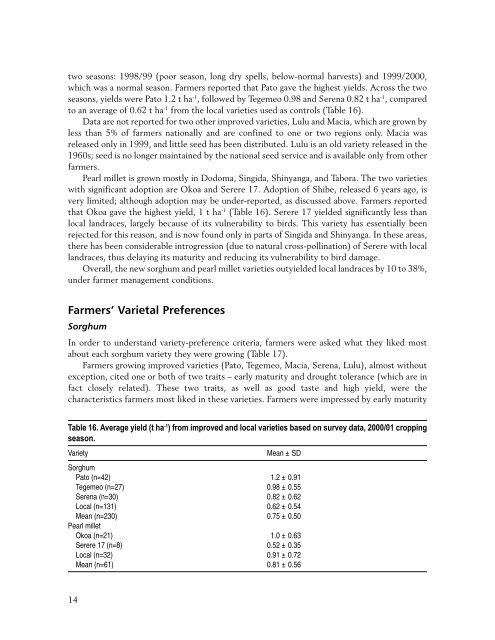Adoption of Improved Sorghum and Pearl Millet ... - Icrisat
Adoption of Improved Sorghum and Pearl Millet ... - Icrisat
Adoption of Improved Sorghum and Pearl Millet ... - Icrisat
Create successful ePaper yourself
Turn your PDF publications into a flip-book with our unique Google optimized e-Paper software.
two seasons: 1998/99 (poor season, long dry spells, below-normal harvests) <strong>and</strong> 1999/2000,<br />
which was a normal season. Farmers reported that Pato gave the highest yields. Across the two<br />
seasons, yields were Pato 1.2 t ha -1 , followed by Tegemeo 0.98 <strong>and</strong> Serena 0.82 t ha -1 , compared<br />
to an average <strong>of</strong> 0.62 t ha -1 from the local varieties used as controls (Table 16).<br />
Data are not reported for two other improved varieties, Lulu <strong>and</strong> Macia, which are grown by<br />
less than 5% <strong>of</strong> farmers nationally <strong>and</strong> are confined to one or two regions only. Macia was<br />
released only in 1999, <strong>and</strong> little seed has been distributed. Lulu is an old variety released in the<br />
1960s; seed is no longer maintained by the national seed service <strong>and</strong> is available only from other<br />
farmers.<br />
<strong>Pearl</strong> millet is grown mostly in Dodoma, Singida, Shinyanga, <strong>and</strong> Tabora. The two varieties<br />
with significant adoption are Okoa <strong>and</strong> Serere 17. <strong>Adoption</strong> <strong>of</strong> Shibe, released 6 years ago, is<br />
very limited; although adoption may be under-reported, as discussed above. Farmers reported<br />
that Okoa gave the highest yield, 1 t ha -1 (Table 16). Serere 17 yielded significantly less than<br />
local l<strong>and</strong>races, largely because <strong>of</strong> its vulnerability to birds. This variety has essentially been<br />
rejected for this reason, <strong>and</strong> is now found only in parts <strong>of</strong> Singida <strong>and</strong> Shinyanga. In these areas,<br />
there has been considerable introgression (due to natural cross-pollination) <strong>of</strong> Serere with local<br />
l<strong>and</strong>races, thus delaying its maturity <strong>and</strong> reducing its vulnerability to bird damage.<br />
Overall, the new sorghum <strong>and</strong> pearl millet varieties outyielded local l<strong>and</strong>races by 10 to 38%,<br />
under farmer management conditions.<br />
Farmers’ Varietal Preferences<br />
<strong>Sorghum</strong><br />
In order to underst<strong>and</strong> variety-preference criteria, farmers were asked what they liked most<br />
about each sorghum variety they were growing (Table 17).<br />
Farmers growing improved varieties (Pato, Tegemeo, Macia, Serena, Lulu), almost without<br />
exception, cited one or both <strong>of</strong> two traits – early maturity <strong>and</strong> drought tolerance (which are in<br />
fact closely related). These two traits, as well as good taste <strong>and</strong> high yield, were the<br />
characteristics farmers most liked in these varieties. Farmers were impressed by early maturity<br />
Table 16. Average yield (t ha -1 ) from improved <strong>and</strong> local varieties based on survey data, 2000/01 cropping<br />
season.<br />
Variety<br />
Mean ± SD<br />
<strong>Sorghum</strong><br />
Pato (n=42) 1.2 ± 0.91<br />
Tegemeo (n=27) 0.98 ± 0.55<br />
Serena (n=30) 0.82 ± 0.62<br />
Local (n=131) 0.62 ± 0.54<br />
Mean (n=230) 0.75 ± 0.50<br />
<strong>Pearl</strong> millet<br />
Okoa (n=21) 1.0 ± 0.63<br />
Serere 17 (n=8) 0.52 ± 0.35<br />
Local (n=32) 0.91 ± 0.72<br />
Mean (n=61) 0.81 ± 0.56<br />
14

















